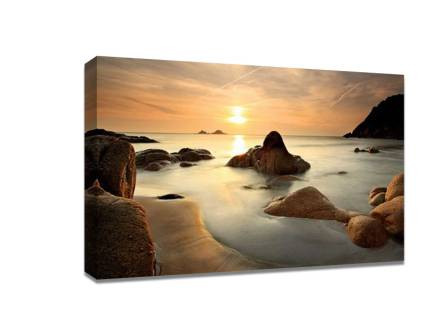5 Practical Tips for Capturing Stunning Seascape Photos
Seascape photography is a beautiful and rewarding way to capture the vastness and serenity of the ocean. Whether you’re a seasoned photographer or just getting started, these five practical tips will help you take stunning seascape photos that will look incredible when turned into canvas prints. Let’s dive in!
1. Choose the Right Time of Day
Timing is everything in photography, and when it comes to seascapes, the best times to shoot are during the golden hours—shortly after sunrise and before sunset. During these times, the light is softer, warmer, and creates long shadows that add depth and interest to your photos. The light also helps in highlighting the textures of the water and clouds, bringing out the natural beauty of the scene. If you’re shooting midday, you might end up with harsh shadows and overexposed areas. So, plan your photoshoots around these golden hours for optimal results.
2. Use a Wide-Angle Lens
A wide-angle lens is ideal for capturing seascapes because it allows you to include more of the scene, from the vast ocean to the sky and the beach. This type of lens enables you to take sweeping shots that emphasize the grandeur of the landscape. A lens with a focal length between 16mm and 35mm is generally best for seascape photography, giving you the ability to capture both the foreground and the distant horizon in sharp focus. Remember to focus your lens to infinity to keep both the foreground and background sharp.
3. Focus on Composition
Composition plays a crucial role in making your seascape photos visually compelling. The Rule of Thirds is a great place to start. Imagine dividing your frame into a 3x3 grid and place your horizon line along one of the horizontal lines. This will help balance the photo and make it more dynamic. Don’t be afraid to experiment with different perspectives and angles. For instance, shooting from a low angle can add drama to crashing waves, while looking down on the scene from above can offer a unique, sweeping view of the coastline. Leading lines, like a shoreline or a path in the sand, can guide the viewer’s eye and add depth to your photo.
4. Master Long Exposure Photography
Long exposure photography can transform the movement of water into smooth, silky textures, turning waves and tides into ethereal, dreamlike elements in your photo. To achieve this effect, you’ll need a tripod to keep your camera steady during the long exposure and a small aperture (high f-stop) to ensure a sharp depth of field. Depending on the time of day and how much light is available, you may also need an ND (neutral density) filter to prevent overexposure. Experiment with exposure times, typically anywhere from 1-10 seconds, depending on the water’s movement and the desired effect.
5. Post-Processing for Impact
Once you've captured your seascape, post-processing is essential to enhance your photos and bring out their full potential. Adjusting the contrast, highlights, and shadows can help balance the exposure and bring out fine details in the clouds and water. Enhance the colors for vibrancy, but be mindful not to overdo it—natural colors will have the most impact when creating realistic and beautiful seascapes. Sharpening the details in the foreground, like rocks or sand, can also add depth and texture to your image. If you plan to print your seascape on canvas prints, you may also want to adjust the image’s resolution to ensure that it retains sharpness and detail when enlarged.
Conclusion:
By using these tips, you’ll be able to take stunning seascape photos that capture the natural beauty of the ocean and sky. Whether you're shooting during golden hour, experimenting with long exposures, or focusing on composition, these strategies will help elevate your photography. Once you have your perfect shot, consider turning your seascape into a timeless piece of art by printing it on canvas prints—a great way to showcase the beauty of nature in your home.
Recent Posts
-
Save on Canvas Prints: Where to Get the Best Canvas Printing Deals
Canvas prints are a timeless way to showcase your favorite memories, enhance your home décor, or eve …9th Jan 2026 -
How to Use Personalized Canvas Prints to Showcase Your Travels
Travel is more than a destination—it is a collection of moments, emotions, and stories worth preserv …6th Jan 2026 -
The Different Types of Canvas Prints: Matte, Glossy, and Textured Finishes Explained
When shopping for wall art, many customers focus on image quality and price, but often overlook one …4th Jan 2026
